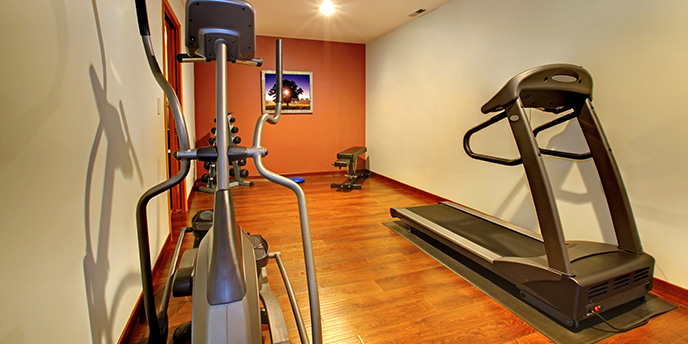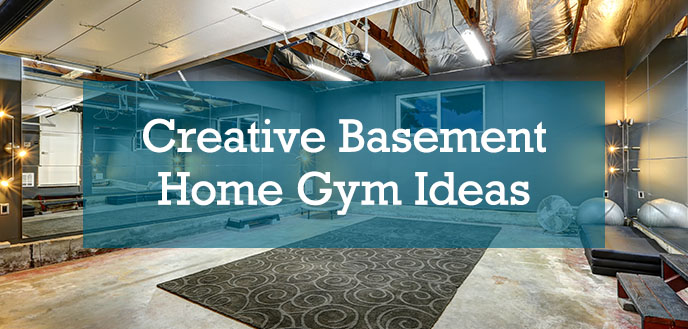Many people are working from home, so what’s stopping us from saving on gym membership fees and working out from home, too? You may think your house doesn’t have room to set up a home gym, but the space you need could be lying right beneath your feet – in the basement.
With these ideas for building a home gym in your basement, you’ll start sweating during your lunch break in no time.
What to Consider for a DIY Basement Gym
Before you begin your basement home gym project, ask yourself the following questions:
- Is my basement space large enough for a gym? The American Council on Exercise advises that you need only 50 to 200 square feet for multi-purpose exercise.
- Are the ceilings high enough? If you plan on using a barbell for power lifting, make sure you have enough room for the barbell overhead and space behind or in front of you to drop your weight without damaging anything. The building code for a basement requires only 7’ of ceiling height, but 8’ is ideal.
- Does my basement have proper ventilation? If your basement has windows, ventilation won’t be a problem. If it does not, you can install an exhaust fan or ceiling fan if you have enough space.
- Do I have access to electrical outlets? Many cardio machines require electricity. To avoid a safety hazard with extension cords on the floor, make sure you have a sufficient number of electrical outlets.
- What is my budget? A great way to keep this endeavor budget-friendly is to scour the internet for used equipment. You can start by looking at Facebook Marketplace, Craigslist or at local garage sales.

5 Ideas for Setting Up a Home Gym in Your Basement
1. Make it a Space You Want to Spend Time In
Start your basement home gym transition by making sure it’s a place where you’ll enjoy working out. You’ll be less likely to actually use the space if it’s cluttered or feels uninviting. Measure the room carefully to see what you can fit and start decluttering as needed.
- Donate Unwanted Items: If there’s clutter of unused junk in your basement getting in the way of a home gym conversion, consider putting a box of items together to take to a local charity. Be sure to check what your local charity will accept ahead of time before dropping off your items.
- Toss Any Junk: If there are electronics, appliances, furniture or other bulky items in your basement that are broken or cannot be donated, consider putting them out on the curb.
- Relocate Things You Want: If you don’t want to get rid of the things in your basement, try finding space for them in other parts of the house, such as in the attic or garage. It may also be worth dividing the room so that a portion of the space is dedicated to gym equipment while the rest can still be used as living or storage space.
“You must measure up the space you have accurately, and purchase equipment based on these measurements. This is especially relevant if you have a small basement. Also be aware that exercise equipment has a certain footprint, but this is usually not how much actual room you’ll need for it. Pretty much all exercise equipment will have a ‘functional footprint’, which is the total space you need to effectively use the equipment. This will generally include at least a few feet in front of, behind, or beside the equipment (or all of the above).”
Eamonn Leaver | TheHomeFitFreak.com
Unfinished Basement Gym Ideas
Creating a basement workout room will look slightly different depending on if your basement is finished or not. If the room is considered finished (carpet, drywall and insulation have been installed), you may need to remove furniture or fixtures to make room for exercise equipment.
If your space is unfinished, you have a clean slate to work with, but will want to keep these things in mind before getting started:
- Waterproof your basement if it isn’t already to protect your expensive exercise equipment from potential water damage.
- Rid your basement of any mold or potential pests that may be lurking. This is most likely a job for the professionals.
- Repair any cracks in your concrete walls or flooring. This may also be a job for the professionals to ensure the cracks are just non-structural settlement cracks and not signs of a larger problem.
2. Proper Flooring is Just as Important as Equipment
Although you could exercise on bare concrete or a carpeted floor, this isn’t ideal for your comfort or safety. If you’re committed to creating a basement workout room, but the room is already finished with carpet or tile, you may want to remove the existing flooring to start.
Below are a few of the most common types of basement gym flooring materials, as well as their estimated costs:
- Rubber Mats: Rubber is a versatile material that can support even the heaviest equipment and offers great shock absorption. It comes in interlocking tiles and rollable mats that can easily be installed in rooms. But at $3 to $8 per square foot, it can be more expensive than other options.
- Foam Tiles: This gym flooring option sports good shock resistance and a comfort factor that makes it well-suited for lower-impact exercises like yoga and Pilates. However, it doesn’t stand up well to heavier equipment like weight benches. Foam tiles can run between $1 to $5 per square foot.
- Vinyl Panels: Floor panels made of vinyl are a practical choice if you’re looking for a material that can withstand the rigors of home exercise while still looking presentable. Though it lacks the raw durability of rubber, it is easier to clean and maintain than other materials. Vinyl tiles also run between $1 and $5 per square foot. If you go this route, be sure to have a yoga mat handy for any kind of stretching or floor exercises that involve kneeling.
“Bare concrete or carpet may seem sufficient for your basement gym, but proper flooring will make a huge difference to the look, feel, and functionality of your basement gym. Good rubber flooring is perfect. It feels good under the feet, is easy to keep clean and looks great. Lots of suppliers sell jigsaw-style interlocking rubber tiles that you can use to surface any size or shape basement gym.”
Eamonn Leaver | TheHomeFitFreak.com

3. Choose Gear That Matches Your Goals
One of the most important factors to consider when setting up a home gym in your basement is what you plan to fill the room with. Different equipment offers different workouts and health benefits, so think about what you hope to accomplish in your basement home gym.
Below are a few of the most popular staples of the average home gym:
- Weight Rack or Bench Press: A typical weight bench measures around 48 inches long by 14 inches wide. A weight rack can vary in size depending on the weights you intend to use, but they usually sit against walls to cause less of an obstruction.
- Elliptical or Stair Climber: A popular machine that is useful for full-body cardiovascular exercises. These can vary in size but are typically around six feet long.
- Treadmill: A classic cardio machine that can help build long-term endurance. The average treadmill measures around 64 inches long by 28 inches wide.
- Stationary Bike: These machines provide excellent cardiovascular routines and are relatively small, with most models measuring between 35 and 48 inches long.
- Rower: This machine offers a low-impact but thorough upper-body and core workout by engaging the arms, shoulders and abdominals. Most rowing machines can also be folded up for easier storage.
- Punching Bag: Boxing and kickboxing are high-intensity cardio workouts that engage the upper body and core muscles. Both heavy bags and speed bags can be mounted from the ceiling or installed on standing bases.
4. Create the Right Aesthetic to Stay Motivated
Along with decluttering your space to make it a place you want to spend time in, another basement gym idea is to make the room visually appealing to increase motivation. Think of the perks you had at the last gym you attended. What kept you showing up?
- Install Overhead Lighting: Choose lighting that is classified as “daylight” or has a listed color temperature of 5000k. 5000k is the same color temperature as the midday sun. If you plan to do some yoga or meditating, you may want to include a dimming option.
- Decorate the Walls: Spruce up the space by adding inspirational art, photos or a mural to your gym walls.
- Hang Mirrors: Choose a wall to add a mirror for form check (and gym selfies).
- Add a Whiteboard or Chalkboard: Use these to write down the steps of your workout or daily motivational quotes.
- Crank Up the Music: Connect a sound system or a portable speaker to play music during workouts. Include a TV if you need a distraction while you’re on the treadmill or want to follow along with online or virtual classes.
- Hydration Station: If space allows, set up a mini refrigerator for easy hydration.
5. Keep It Safe and Clean
Depending on your equipment of choice, you’ll want to set aside some space for storage. Below are a few ideas you can look into to create storage solutions in your basement home gym:
- Weight Racks: If you’re interested in strength training with free weights or dumbbells, a weight rack against the wall is essential for keeping these weights organized and out of the way when not in use.
- Wall Storage: Shelves and simple hooks on the wall can be used to keep resistance bands, yoga mats and other fitness accessories organized between workouts.
- Plastic Bins: If a closet isn’t available nearby, a simple Tupperware tub can hold weights, kettlebells, yoga blocks and other exercise accessories.
- Hygiene Corner: Set up a table or shelf to keep sweat towels, microfiber cloths, antibacterial spray and hand sanitizer to keep your gym sparkling clean.
Not Finished With Your Basement Makeover?
If you have additional unused space after you finish your basement workout room, consider keeping the makeover momentum going with these additional projects:











